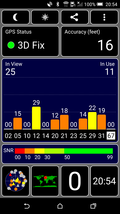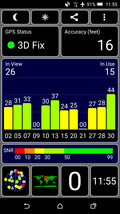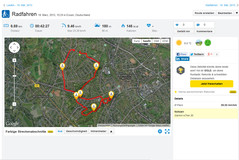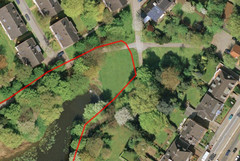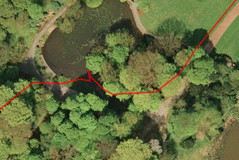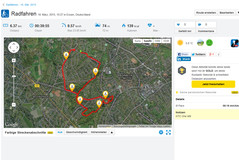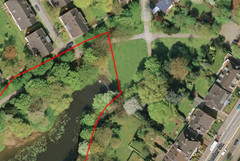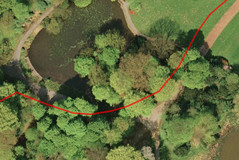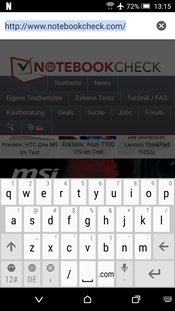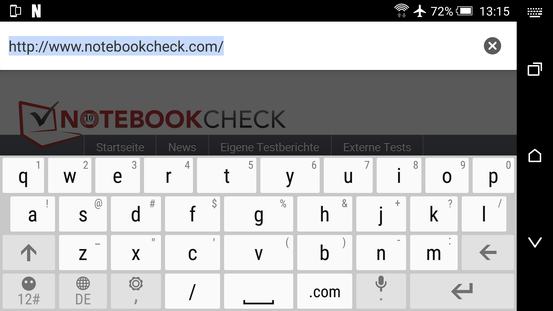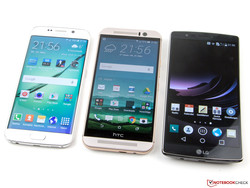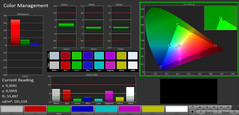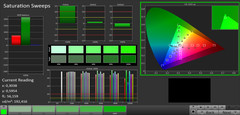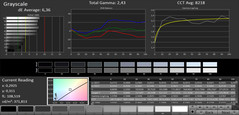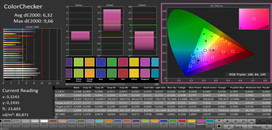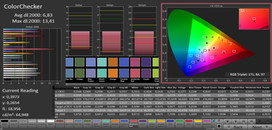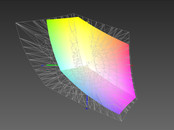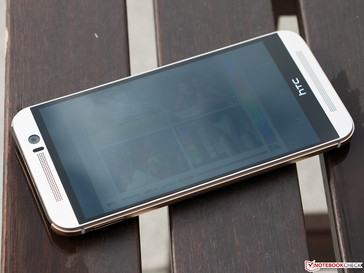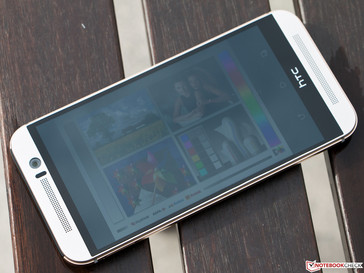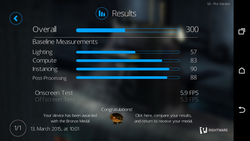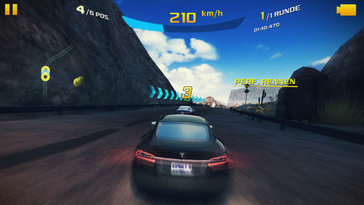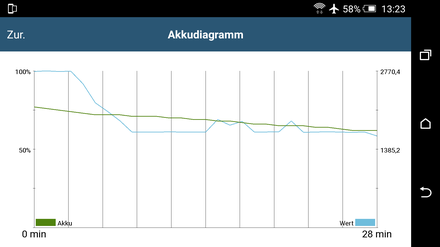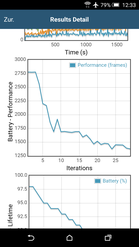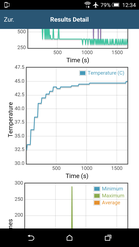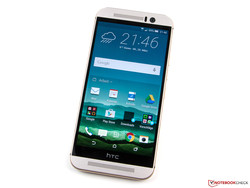HTC One M9 Smartphone Review

For the original German review, see here.
The HTC One M9 is the successor of the One M8. Thanks to the new Snapdragon 810, the smartphone wants to reclaim the performance crown. The operating system is now Google’s Android 5.0 Lollipop, which has a 64-bit architecture. HTC wants to use this with the integration of 3 GB memory. The latest communication modules are available as well, so the One M9 is a modern high-end smartphone in a very noble aluminum chassis. The manufacturer also increased the price and the RRP is now at 749 Euros (~$839).
There are numerous and well-known competitors, including the Samsung Galaxy S5, which will soon be replaced by the S6 and S6 Edge, as well as the Sony Xperia Z3, LG G3, Nexus 6, Motorola Moto X, Huawei Ascend P7, OnePlus One, Nokia Lumia 930 and Apple iPhone 6.
Case
HTC only changed small details for the chassis of the One M9. The smartphone is slightly thicker now, but it is slimmer at the edges in return. The silver version is also available with a golden edge, but you also get completely golden, pink and dark gray models. Because of the curved back, the review unit feels nice in the hand, but the edges are a bit hard.
The stability of the aluminum chassis is flawless. Neither attempts to twist the smartphone nor pressure can affect the One M9. The IPX3 certification ensures sufficient protection against light to medium rain.
The gaps are very even. A small issue is that the slots for the nano-SIM card and the microSD are not perfectly flush with the rest of the chassis. The battery is integrated and cannot be removed without the corresponding expert knowledge.
Connectivity
The micro USB 2.0 port of the HTC One M9 can be used to charge the smartphone and also for file transfers with a computer. It also supports OTG and MHL 3.0, so not only can you attach external input devices as well as memory sticks, but the interface can also be used to transfer video data in Ultra HD. Wireless video signals can be transmitted via HTC Connect, Miracast and DLNA.
The microSD slot is supposed to support cards with a size of up to 2 TB. This is the current theoretical maximum of the SDXC standard, but you can only buy cards with up to 256 GB right now.
An Infrared transmitter is once again included as well, so you can control your home entertainment system.
Software
The operating system of the HTC One M9 is Google Android 5.0.2 Lollipop, which is the most recent version at the time of writing. The manufacturer also added its own user interface (UI) HTC Sense 7, but the design is very similar to the predecessor and you only get some new elements of the material design. The interface is very clean and simple. Besides some HTC apps, which are usable after you use an HTC account, there is just one third-party app with Polaris Office 5. HTC itself offers its Club app, a backup function as well as the familiar Zoe app. A new feature is that the shown apps on the home screen are adjusted to the situation, so you see different apps at home, on the road or at the office.
Communication & GPS
The HTC One M9 can establish mobile Internet connections via fast LTE Cat. 6 (up to 300 Mbps), that is, of course, if your provider supports those high transfer rates. In theory, the MSM8994 even supports LTE Cat. 9 (up to 450 Mbps). This is not supported by the network carriers yet, but it would have been nice if it was supported by the One M9. It is just a matter of time before it will be available. It is also possible to use HSPA+ (up to 42 Mbps) for Internet connections.
The smartphone also has a WLAN module that supports the IEEE-802.11 standards a/b/g/n/ac in 2.4 as well as 5 GHz networks. The signal quality of the Wi-Fi connection is good, and we still had an average signal pretty far away from the Access Point (Devolo dLAN 1200+ Wi-Fi ac, 2.4 GHz). Websites are still opened quickly, and subjectively there is no difference whether we are 20 meters away from the AP or right next to it.
Besides NFC, the HTC One M9 also supports the current Bluetooth standard 4.1. The Bluetooth signal was very stable during our review and it was no problem to move away from the speaker during music streaming without distortions. The transmission even worked without problems in another room.
The HTC One M9 uses the GPS and Glonass network to locate your position. It also found Chinese BeiDou satellites in our review. The location process is pretty fast and accurate indoors, and the performance is even better outdoors with accuracy down to five meters, which is a good value.
We also checked the accuracy with the navigation device Garmin eTrex 30. The smartphone does have some issues when the track is narrow or if the environment affects the signal quality, but the result is still pretty good and sometimes even better compared to the Garmin.
Telephone & Voice Quality
The voice quality of the HTC One M9 can convince in the review. It was no problem to hear the other person both on mobile networks and landlines. The user of the review unit was always clearly understandable as well. Even the speaker can convince in a quiet environment. Users that make many calls will be happy with the One M9.
Cameras
The UltraPixel camera of the One M8 is now located at the front and is supposed to take good selfies. It has a 4 MP sensor (1688x1520 pixels) and cannot convince us completely. The pictures are decent in good lighting conditions, but you can see a red cast as soon as there is some back-light and the sharpness, which is not great to begin with, will decrease a bit.
The main camera at the back of the HTC One M9 takes pictures with up to 20.1 MP (5376x3752 pixels), which means the number of pixels is five times higher compared to the predecessor. But a high resolution does not always help a lot, which is, unfortunately, also the case for the review unit. The camera is decent, but still noticeably behind other top smartphones. The environment pictures (scene 1) suffer from blurry contours like the roof tiles. The LG G3 is a bit sharper, and the performance of the Lumia 1020 is pretty impressive. The grass is just a green area on the picture from the M9. The review unit cannot quite keep up with the rivals in the second scene, either. The colors are too pale and details look frayed. The Taiwanese smartphone quickly reveals issues in low-light environments (scene 3) and the pictures are blurry. If you use the flash (scene 4), the colors will look washed-out and unnatural, but the result is still not really sharp.
Videos with the HTC One M9 can be recorded in UltraHD (3840x2160 pixels, 16:9, 30 fps). The results are actually pretty good if you avoid quick movements. Unfortunately, the frame rate cannot be adjusted.
Accessories
The HTC One M9 is shipped with an in-ear headset, which has a cable that does not knot, a modular power adaptor (7.5 Watts, 5 V, 1.5 A), a small tool to open the slots as well as a data cable.
HTC also offers optional accessories in its shop, including the DotView cover (39 Euros, ~$43) as well as external battery packs, speakers and headsets.
Warranty
HTC grants a warranty of 24 months for its top smartphone, which cannot be extended.
Input Devices & Handling
The main input device of the HTC One M9 is, as usual, the capacitive touchscreen. It supports up to 10 inputs simultaneously and has convenient gliding capabilities. Inputs are executed quickly and reliably, and there are no problems in the peripheral areas, either.
The Android buttons are on-screen, which means they occupy a part of the display. This is not a big problem for the handling, but users will lose screen estate in some applications.
The volume rocker and the power button have a short travel and a firm pressure point. Not only do they look sophisticated, but they also feel this way. The haptics are, unfortunately, very similar, so there can be accidental inputs in the beginning since the three buttons are very close to each other.
The virtual keyboard automatically predicts words and is sophisticated. All important symbols are easy to reach, but the space bar is, unfortunately, a bit narrow in portrait mode. Because of the multiple functions of the keys, the layout can be a bit crowded at first. It is annoying that HTC does not offer a QWERTZ-layout for German users after the initial setup but a QWERTY-layout. This can, however, be changed in the settings.
Display
The HTC One M9 once again has a Super LCD 3 panel with a resolution of 1920x1080 pixels. This results in an aspect ratio of 16:9 and a pixel density of 441 ppi. Even though the Taiwanese are not following the QHD trend yet, the display is still razor sharp. Aliasing or individual pixels are not visible with the human eye.
The luminance of the screen is pretty high with up to 492 cd/m² and is only beaten by the iPhone 6 (up to 529 cd/m², 88%) and the Sony Xperia Z3 (up to 702 cd/m², 90%). The brightness distribution of the review unit is, however, not very even at 85%, but this is not really a problem in practice. The One M8 (up to 508 cd/m², 93%) was a bit better in this respect.
| |||||||||||||||||||||||||
Brightness Distribution: 85 %
Center on Battery: 474 cd/m²
Contrast: 1185:1 (Black: 0.4 cd/m²)
ΔE Color 6.32 | 0.5-29.43 Ø5
ΔE Greyscale 6.36 | 0.57-98 Ø5.3
58.81% AdobeRGB 1998 (Argyll 1.6.3 3D)
Gamma: 2.43
| HTC One M9 Adreno 430, 810 MSM8994, 32 GB eMMC Flash | HTC One M8 Adreno 330, 801 MSM8974AB, 16 GB iNAND Flash | Samsung Galaxy S5 Adreno 330, 801 MSM8974AC, 16 GB eMMC Flash | LG G3 Adreno 330, 801 MSM8974AC, 16 GB eMMC Flash | Huawei Ascend P7 Mali-450 MP4, Kirin 910T, 16 GB eMMC Flash | Nokia Lumia 930 Adreno 330, 800 MSM8974, 32 GB eMMC Flash | Apple iPhone 6 PowerVR GX6450, A8, 128 GB eMMC Flash | |
|---|---|---|---|---|---|---|---|
| Screen | -3% | -1% | -25% | -15% | -36% | 2% | |
| Brightness middle | 474 | 474 0% | 358 -24% | 417 -12% | 464 -2% | 275 -42% | 520 10% |
| Brightness | 458 | 486 6% | 364 -21% | 395 -14% | 470 3% | 278 -39% | 511 12% |
| Brightness Distribution | 85 | 93 9% | 82 -4% | 89 5% | 92 8% | 89 5% | 88 4% |
| Black Level * | 0.4 | 0.54 -35% | 0.96 -140% | 0.92 -130% | 0.61 -53% | ||
| Contrast | 1185 | 878 -26% | 434 -63% | 504 -57% | 852 -28% | ||
| Colorchecker dE 2000 * | 6.32 | 5.86 7% | 5.28 16% | 5.67 10% | 4.18 34% | 10.99 -74% | 3.92 38% |
| Greyscale dE 2000 * | 6.36 | 5.2 18% | 4.65 27% | 5.66 11% | 3.71 42% | 8.29 -30% | 4.33 32% |
| Gamma | 2.43 91% | 2.29 96% | 2.48 89% | 2.53 87% | 2.48 89% | 2.16 102% | 2.46 89% |
| CCT | 8218 79% | 7218 90% | 7690 85% | 7741 84% | 6441 101% | 6731 97% | 7384 88% |
| Color Space (Percent of AdobeRGB 1998) | 58.81 | 59 0% |
* ... smaller is better
The black value of the HTC One M9 was slightly improved compared to the predecessor and now reaches 0.4 cd/m². Black looks pretty rich and deep but cannot compete with AMOLED screens that are used by rivals like the Lumia 930 or the Moto X. The contrast ratio of the review unit is correspondingly high and reaches 1,185:1. A very good result.
Our measurements of the color accuracy, however, are worse compared to the M8. We analyzed the performance with a spectrophotometer and the software CalMAN and noticed some pretty big deviations. Red colors showed a shift towards blue, and the grayscale showed a blue cast as well. The highest DeltaE deviation is 13. The saturation sweeps show that the colors are not rich enough and therefore appear a bit pale. The color-space coverage is also just average with around 59% AdobeRGB 1998, but this won’t be a big problem for many users.
The impression of the HTC One M9 outdoors is okay, but we would have expected a better performance considering the high luminance and the good contrast ratio. The picture is pretty dark on bright days and under sunlight in particular, and the glossy surface can affect the visibility of the screen content noticeably.
Performance
Qualcomm’s Snapdragon 810 MSM8994 inside the HTC One M9 is currently one of the fastest SoCs on the market. The octa-core chip uses ARM’s big.LITTLE concept, in this case with a quad-core Cortex-A57 configuration that runs with up to 2.0 GHz and a Cortex-A15 configuration (up to 1.5 GHz) that supports 64-bit. Depending on the required performance, the smartphone uses the 20 nm cores. It is also possible that all cores run simultaneously for a short while under maximum load. Graphics are handled by the Qualcomm Adreno 430. The system is supported by 3 GB of fast LPDDR4 memory.
The system performance is very good, and you only need some patience when you launch complex applications like games. There can also be some small stutters if you stop demanding apps.
The performance of the HTC One M9 is convincing in the benchmarks. The processor is unbeaten in the Geekbench 3 multi-core test and 11% faster than the Snapdragon 805 inside the Google Nexus 6. Only the iPhone 6, which has a very good per-MHz performance, manages better single-core results.
The Adreno 430 can set new records in the graphics benchmark and reaches 24 fps in the GFXBench 3.0 Manhattan Offscreen test, which is 21% more than the Nexus 6 (Adreno 420) and 29% faster than the iPhone (PowerVR GX6450). Only the 3DMark Unlimited result is worse than expected, and the Nexus 6 is much better in this test. This is, however, not the fault of the GPU, but the Physics results falls behind the rivals. The M9 can probably not use all cores, but just one of the quad-cores. The quad-cores of the rivals have a higher clock, so their results are better.
| PCMark for Android - Work performance score (sort by value) | |
| HTC One M9 | |
| LG G3 | |
| LG G3 | |
| OnePlus One | |
| AnTuTu v5 - Total Score (sort by value) | |
| HTC One M9 | |
| LG G3 | |
| Sony Xperia Z3 | |
| Google Nexus 6 | |
| Motorola Moto X 2. Gen 2014 | |
| Apple iPhone 6 | |
| OnePlus One | |
| ANDEBench PRO | |
| Device Score (sort by value) | |
| HTC One M9 | |
| LG G3 | |
| OnePlus One | |
| CoreMark-PRO/HPC (Base) (sort by value) | |
| HTC One M9 | |
| LG G3 | |
| OnePlus One | |
| Memory Bandwidth (sort by value) | |
| HTC One M9 | |
| LG G3 | |
| OnePlus One | |
| Memory Latency (sort by value) | |
| HTC One M9 | |
| LG G3 | |
| OnePlus One | |
| Storage (sort by value) | |
| HTC One M9 | |
| LG G3 | |
| OnePlus One | |
| Platform (sort by value) | |
| HTC One M9 | |
| LG G3 | |
| OnePlus One | |
| 3D (sort by value) | |
| HTC One M9 | |
| LG G3 | |
| OnePlus One | |
| 3DMark | |
| 1280x720 offscreen Ice Storm Unlimited Score (sort by value) | |
| HTC One M9 | |
| HTC One M8 | |
| Samsung Galaxy S5 | |
| LG G3 | |
| Sony Xperia Z3 | |
| Google Nexus 6 | |
| Motorola Moto X 2. Gen 2014 | |
| Huawei Ascend P7 | |
| Apple iPhone 6 | |
| OnePlus One | |
| 1280x720 offscreen Ice Storm Unlimited Graphics Score (sort by value) | |
| HTC One M9 | |
| HTC One M8 | |
| Samsung Galaxy S5 | |
| LG G3 | |
| Sony Xperia Z3 | |
| Google Nexus 6 | |
| Motorola Moto X 2. Gen 2014 | |
| Huawei Ascend P7 | |
| Apple iPhone 6 | |
| OnePlus One | |
| 1280x720 offscreen Ice Storm Unlimited Physics (sort by value) | |
| HTC One M9 | |
| HTC One M8 | |
| Samsung Galaxy S5 | |
| LG G3 | |
| Sony Xperia Z3 | |
| Google Nexus 6 | |
| Motorola Moto X 2. Gen 2014 | |
| Huawei Ascend P7 | |
| Apple iPhone 6 | |
| OnePlus One | |
| GFXBench 3.0 | |
| on screen Manhattan Onscreen OGL (sort by value) | |
| HTC One M9 | |
| HTC One M8 | |
| Samsung Galaxy S5 | |
| LG G3 | |
| Sony Xperia Z3 | |
| Google Nexus 6 | |
| Motorola Moto X 2. Gen 2014 | |
| Apple iPhone 6 | |
| OnePlus One | |
| 1920x1080 1080p Manhattan Offscreen (sort by value) | |
| HTC One M9 | |
| HTC One M8 | |
| Samsung Galaxy S5 | |
| LG G3 | |
| Sony Xperia Z3 | |
| Google Nexus 6 | |
| Motorola Moto X 2. Gen 2014 | |
| Apple iPhone 6 | |
| OnePlus One | |
The browser performance of the HTC One M9 is very good, which is confirmed by the benchmark results, even though it cannot compete with the excellent performance of the iPhone. Websites are quickly opened and scrolling through websites is smooth. There are only some small stutters on complex websites.
| Octane V2 - Total Score (sort by value) | |
| HTC One M9 | |
| HTC One M8 | |
| Samsung Galaxy S5 | |
| LG G3 | |
| LG G3 | |
| Sony Xperia Z3 | |
| Google Nexus 6 | |
| Motorola Moto X 2. Gen 2014 | |
| Huawei Ascend P7 | |
| Apple iPhone 6 | |
| Nokia Lumia 930 | |
| Browsermark - 2.1 (sort by value) | |
| HTC One M9 | |
| LG G3 | |
| LG G3 | |
| Motorola Moto X 2. Gen 2014 | |
| Apple iPhone 6 | |
| Nokia Lumia 930 | |
| OnePlus One | |
| Peacekeeper - --- (sort by value) | |
| HTC One M9 | |
| HTC One M8 | |
| Samsung Galaxy S5 | |
| LG G3 | |
| Sony Xperia Z3 | |
| Motorola Moto X 2. Gen 2014 | |
| Huawei Ascend P7 | |
| Apple iPhone 6 | |
| Nokia Lumia 930 | |
| OnePlus One | |
| Vellamo 3.x - Browser (sort by value) | |
| HTC One M9 | |
| LG G3 | |
| LG G3 | |
| Sony Xperia Z3 | |
| Google Nexus 6 | |
| Motorola Moto X 2. Gen 2014 | |
| OnePlus One | |
| Google V8 Ver. 7 - Google V8 Ver. 7 Score (sort by value) | |
| HTC One M9 | |
| LG G3 | |
| Google Nexus 6 | |
| Motorola Moto X 2. Gen 2014 | |
| Apple iPhone 6 | |
| OnePlus One | |
* ... smaller is better
The HTC One M9 has 32 GB eMMC flash storage and the user can use around 21 GB after the initial start. The rest is occupied by the system and preloaded apps. If this is not enough you can expand the storage with a microSD card (up to 256 GB). Bigger SDXC cards are currently not available and they are also pretty expensive. App2SD is supported, so applications can also be transferred to the optional storage and used from there.
The performance of the flash storage inside the HTC One M9 is also very good and the overall performance is fast. Only some smartphone rivals are faster in some areas, but the review unit is always on the podium. It is even the fastest Android device in Basemark OS II and PassMark.
| BaseMark OS II - Memory (sort by value) | |
| HTC One M9 | |
| LG G3 | |
| Google Nexus 6 | |
| Motorola Moto X 2. Gen 2014 | |
| Apple iPhone 6 | |
| Nokia Lumia 930 | |
| OnePlus One | |
Games
Gaming is a strength of the HTC One M9. This is not only because of the high-end SoC from Qualcomm, which provides a great performance in combination with the Adreno 430, but also the great speakers that create a first-class sound experience. The device also supports all current graphics interfaces, so every title can be enjoyed without stutters and in the highest settings.
The sensors work very well and do not affect the gaming experience if you want to use movement controls. The touchscreen provides good gliding capabilities and executes inputs quickly and precisely.
Emissions
Temperature
The temperature development was already a big topic ahead of the review. One reason is the temperature development of the Snapdragon 810 that caused problems for the manufacturer, which is why Samsung supposedly used its own SoCs for the new S6 series (we reported). The other problem is the insane surface temperatures of the review unit under sustained load that even surpass 50 °C. We determined the latter with GFXBench 3.0 (up to 50.0 °C) and Basemark ES 3.1 (up to 51.1 °C), but HTC reacted quickly and already released an update that improves this issue. The new measurement results are up to 34.0 °C while idling and up to 38.4 °C under sustained load, which is simulated by the app Stability Test.
The situation is different for the temperatures of the SoC. We could not determine any problems with the heat development or negative effects on the performance of the smartphone when we only stressed the CPU. This changes when we look at the GPU: We can see a performance drop of up to 40% (GFXBench 3.0) in the battery tests of GFXBench 3.0 and 3.1 and even more than 50% in the newer version of the graphics benchmark. This means that there can be stutters in a game that is based on OpenGL ES 2.0, which is simulated by the onscreen T-Rex test of the benchmark. The smartphone does reach an excellent result of 50 fps in this test, but the frame rates can drop to 30 fps in practice. This is still a good value, but you would be able to see small delays.
(+) The maximum temperature on the upper side is 38.4 °C / 101 F, compared to the average of 35 °C / 95 F, ranging from 21.9 to 56 °C for the class Smartphone.
(+) The bottom heats up to a maximum of 36.1 °C / 97 F, compared to the average of 33.8 °C / 93 F
(+) In idle usage, the average temperature for the upper side is 30.8 °C / 87 F, compared to the device average of 32.7 °C / 91 F.
Speakers
The HTC One M9 has two stereo speakers that surround the display when you use it in landscape mode. Besides the familiar BoomSound, they now also support Dolby Audio. Similar to the predecessor, the quality can once again convince us. The speakers create a surprisingly good sound for their size. The bass is a bit thin, but perceptible, and the medium tones leave a good impression as well. Even the high tones do not create distortions at the highest volume, so you generally get a harmonious sound experience. Users of the HTC One M9 do not necessarily need an external speaker if you occasionally want to listen to music or watch a video.
Energy Management
Power Consumption
The power consumption of the HTC One M9 is surprisingly high if you consider that Qualcomm advertises better energy efficiency for its new SoC. The values are still higher compared to the predecessor. This is not only caused by the more powerful hardware, because the values are also comparatively high while idling with up to 2.4 Watts. Both the Moto X (idle up to 1.2 Watts) and the OnePlus One (idle up to 1.9 Watts) are more frugal, even though they have bigger screens. Only the LG G3 (up to 9.1 Watts) and the Nexus 6 (up to 10.9 Watts) consumed more power under load.
Although the battery capacity was slightly increased, the measurements do not suggest great results for our battery runtime tests. The HTC One M9 does not support Quick Charge or wireless charging, either.
| Off / Standby | |
| Idle | |
| Load |
|
Battery Runtime
The battery of the HTC One M9 now has a capacity of 2,840 mAh, which is pretty generous for a 5-inch smartphone, but the measured runtimes are still pretty mediocre in comparison: The results in all scenarios are pretty average. It is surprising that almost all values were improved compared to the M8, and the minimum runtime of the M9 is even comparatively good. Still, we would have expected more from a high-end smartphone. If you use your smartphone extensively during the day, you should carry an external battery with you since the battery charge can be dangerously low in the afternoon.
The best comparability is provided by the tests with an adjusted display brightness of 150 cd/m². Only the runtime of the iPhone 6 is shorter in the WLAN test, but the OnePlus One and the Lumia 930 surpass the review unit significantly. The difference is even bigger in the new WLAN test (v 1.3), which does not use Flash and opens a website every 30 seconds.
The HTC One M9 works really well as a multimedia device thanks to the high-resolution panel and the great speakers, so we also test the stamina during the playback of a Netflix HD stream. We once again use an adjusted panel brightness of 150 cd/m² and deactivate all communication modules except for the required network connection. It does not matter if you stream video via WLAN (343 minutes) or LTE (350 minutes), the runtimes are basically identical and ensure good entertainment even on longer journeys.
| HTC One M9 Adreno 430, 810 MSM8994, 32 GB eMMC Flash | HTC One M8 Adreno 330, 801 MSM8974AB, 16 GB iNAND Flash | Samsung Galaxy S5 Adreno 330, 801 MSM8974AC, 16 GB eMMC Flash | OnePlus One Adreno 330, 801 MSM8974AC, 64 GB eMMC Flash | Motorola Moto X 2. Gen 2014 Adreno 330, 801 MSM8974AC, 16 GB eMMC Flash | Nokia Lumia 930 Adreno 330, 800 MSM8974, 32 GB eMMC Flash | Apple iPhone 6 PowerVR GX6450, A8, 128 GB eMMC Flash | |
|---|---|---|---|---|---|---|---|
| Battery Runtime | -20% | 39% | 90% | 14% | 40% | 14% | |
| Reader / Idle | 805 | 863 7% | 1695 111% | 1568 95% | 1078 34% | 1387 72% | 1369 70% |
| H.264 | 421 | 385 -9% | 556 32% | 893 112% | 604 43% | 595 41% | |
| WiFi | 573 | 453 -21% | 613 7% | 1126 97% | 617 8% | 1002 75% | 530 -8% |
| WiFi v1.3 | 348 | 963 177% | |||||
| Load | 236 | 102 -57% | 253 7% | 160 -32% | 165 -30% | 175 -26% | 128 -46% |
Pros
Cons
Verdict
The HTC One M9, unfortunately, lacks any real innovations, but the Taiwanese manufacturer can improve some aspects, so the M9 is a very good smartphone. The high-resolution SLCD3 panel can convince with the high luminance and the good contrast ratio. The device is once again equipped with really good speakers and you won’t find a better solution in any other smartphone.
HTC’s flagship device is a sophisticated aluminum smartphone with current components, but without big innovations. The battery runtimes could be better as well.
The new main camera of the One M9 is certainly a step in the right direction, but there is still a lot of work for HTC compared to the LG G3, Xperia Z3, iPhone 6 or Lumia 930. Maybe there will be a software update that improves the quality of the camera, but the performance right now is a bit weak for a premium product. Another problem is the mediocre battery runtimes.
The connectivity is another positive aspect of the review unit. There are hardly any standards that are not supported by the One M9. Fast LTE Cat. 6 is available, just like the possibility to transfer files wirelessly or via cable to external devices. The HTC One M9 is also a pretty good-looking phone. If the launch price of 749 Euros (~$839) is too high for you, we can recommend the predecessor, which is around 250 Euros (~$280) cheaper.
HTC One M9
-
04/07/2015 v4(old)
Daniel Schmidt


 Deutsch
Deutsch English
English Español
Español Français
Français Italiano
Italiano Nederlands
Nederlands Polski
Polski Português
Português Русский
Русский Türkçe
Türkçe Svenska
Svenska Chinese
Chinese Magyar
Magyar



















